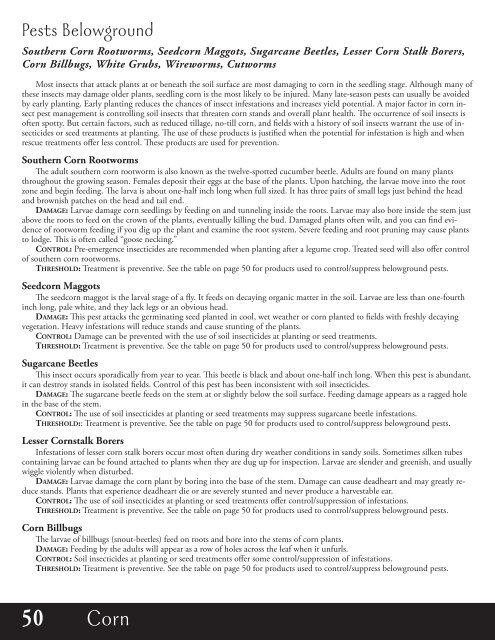Agronomic Crops
mJyPrJ
mJyPrJ
Create successful ePaper yourself
Turn your PDF publications into a flip-book with our unique Google optimized e-Paper software.
Pests Belowground<br />
Southern Corn Rootworms, Seedcorn Maggots, Sugarcane Beetles, Lesser Corn Stalk Borers,<br />
Corn Billbugs, White Grubs, Wireworms, Cutworms<br />
Most insects that attack plants at or beneath the soil surface are most damaging to corn in the seedling stage. Although many of<br />
these insects may damage older plants, seedling corn is the most likely to be injured. Many late-season pests can usually be avoided<br />
by early planting. Early planting reduces the chances of insect infestations and increases yield potential. A major factor in corn insect<br />
pest management is controlling soil insects that threaten corn stands and overall plant health. e occurrence of soil insects is<br />
often spotty. But certain factors, such as reduced tillage, no-till corn, and fields with a history of soil insects warrant the use of insecticides<br />
or seed treatments at planting. e use of these products is justified when the potential for infestation is high and when<br />
rescue treatments offer less control. ese products are used for prevention.<br />
southern Corn Rootworms<br />
e adult southern corn rootworm is also known as the twelve-spotted cucumber beetle. Adults are found on many plants<br />
throughout the growing season. Females deposit their eggs at the base of the plants. Upon hatching, the larvae move into the root<br />
zone and begin feeding. e larva is about one-half inch long when full sized. It has three pairs of small legs just behind the head<br />
and brownish patches on the head and tail end.<br />
DAMAGe: Larvae damage corn seedlings by feeding on and tunneling inside the roots. Larvae may also bore inside the stem just<br />
above the roots to feed on the crown of the plants, eventually killing the bud. Damaged plants often wilt, and you can find evidence<br />
of rootworm feeding if you dig up the plant and examine the root system. Severe feeding and root pruning may cause plants<br />
to lodge. is is often called “goose necking.”<br />
ContRoL: Pre-emergence insecticides are recommended when planting after a legume crop. Treated seed will also offer control<br />
of southern corn rootworms.<br />
tHResHoLD: Treatment is preventive. See the table on page 50 for products used to control/suppress belowground pests.<br />
seedcorn Maggots<br />
e seedcorn maggot is the larval stage of a fly. It feeds on decaying organic matter in the soil. Larvae are less than one-fourth<br />
inch long, pale white, and they lack legs or an obvious head.<br />
DAMAGe: is pest attacks the germinating seed planted in cool, wet weather or corn planted to fields with freshly decaying<br />
vegetation. Heavy infestations will reduce stands and cause stunting of the plants.<br />
ContRoL: Damage can be prevented with the use of soil insecticides at planting or seed treatments.<br />
tHResHoLD: Treatment is preventive. See the table on page 50 for products used to control/suppress belowground pests.<br />
sugarcane Beetles<br />
is insect occurs sporadically from year to year. is beetle is black and about one-half inch long. When this pest is abundant,<br />
it can destroy stands in isolated fields. Control of this pest has been inconsistent with soil insecticides.<br />
DAMAGe: e sugarcane beetle feeds on the stem at or slightly below the soil surface. Feeding damage appears as a ragged hole<br />
in the base of the stem.<br />
ContRoL: e use of soil insecticides at planting or seed treatments may suppress sugarcane beetle infestations.<br />
tHResHoLD:: Treatment is preventive. See the table on page 50 for products used to control/suppress belowground pests.<br />
Lesser Cornstalk Borers<br />
Infestations of lesser corn stalk borers occur most often during dry weather conditions in sandy soils. Sometimes silken tubes<br />
containing larvae can be found attached to plants when they are dug up for inspection. Larvae are slender and greenish, and usually<br />
wiggle violently when disturbed.<br />
DAMAGe: Larvae damage the corn plant by boring into the base of the stem. Damage can cause deadheart and may greatly reduce<br />
stands. Plants that experience deadheart die or are severely stunted and never produce a harvestable ear.<br />
ContRoL: e use of soil insecticides at planting or seed treatments offer control/suppression of infestations.<br />
tHResHoLD: Treatment is preventive. See the table on page 50 for products used to control/suppress belowground pests.<br />
Corn Billbugs<br />
e larvae of billbugs (snout-beetles) feed on roots and bore into the stems of corn plants.<br />
DAMAGe: Feeding by the adults will appear as a row of holes across the leaf when it unfurls.<br />
ContRoL: Soil insecticides at planting or seed treatments offer some control/suppression of infestations.<br />
tHResHoLD: Treatment is preventive. See the table on page 50 for products used to control/suppress belowground pests.<br />
50 Crop Corn Name


